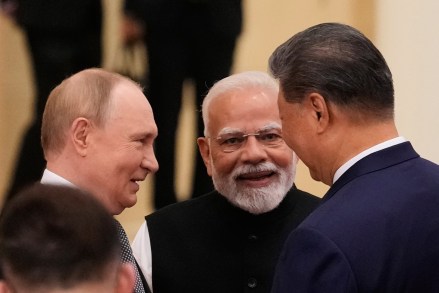By Harsh V Pant & Aleksei Zakharov, respectively vice president and fellow, Russia & Eurasia, Observer Research Foundation
The Shanghai Cooperation Organisation (SCO) Summit in Tianjin was marked by significant representation from the Global South, reminding that the organisation comprises 26 countries, including 10 full members, two observers, and 14 dialogue partners. Yet, one episode arguably stole the whole show. Images of Prime Minister Narendra Modi, President Xi Jinping, and President Vladimir Putin smiling during an informal conversation have widely circulated in the media, with some outlets billing this as a “shift in global power dynamics” or a “redrawn geopolitical map”. The depth of this engagement and its geopolitical ramifications are significantly exaggerated, though one spectator, the US President Donald Trump, appears to have been spellbound.
The idea of a trilateral format dates back to the 1990s. Following its emergence in the form of foreign ministers’ consultations in 2003, it has been one of the most consistent mechanisms of interaction, gathering uninterruptedly until late 2021. However, the appeal of the grouping has gradually evaporated owing to India-China divergences, eroding trust in the relationship.
The Russia-India-China (RIC) trilateral covered a wide range of areas, from global and regional politics, trade, investment, and healthcare, to education. In some ways, in India’s policy calculus, RIC deliberations were seen as reiterating the outputs from the BRICS and SCO—the former’s global governance agenda and the latter’s Eurasian security focus. There were two particular reasons why this trilateral had resonated for such a long time. First, there was much hope that the three Eurasian powers would succeed in finding common ground on critical regional issues, primarily security-related ones. Second, it provided additional leeway for hedging the bets and soft balancing against the West, while maintaining sufficient space for engagement with Western capitals.
When Russia proposed a trilateral meeting between Putin, Modi, and Xi on the sidelines of the 2018 G20 summit, India embraced the idea. At that time, mini-laterals were growing in popularity, creating a momentum for India’s active involvement in the RIC, including informal leaders’ gatherings in December 2018 and June 2019. Notably, these meetings took place concurrently with Japan-US-India summits and India’s participation in the reinvigorated Quad ministerials. All of these formats highlighted New Delhi’s ability to be part of multiple groupings with sometimes conflicting agendas, thereby serving the purpose of India’s multi-alignment.
As with many other mini-laterals, the RIC’s advantage as an informal, narrow-circle forum has also proven to be a weakness. Beyond consultations and the exchange of ideas, it has failed to produce any solutions or large-scale initiatives. Moreover, as RIC engagement has not mitigated India-China divergences at either the global or regional levels, its value for Indian diplomacy has been called into question. One exception where the three countries were able to cooperate was Afghanistan, which was often discussed within the RIC and resulted in deliverables such as the coordination of humanitarian aid to Kabul. At the same time, however, efforts to bridge differences on terrorism and radicalisation have been less productive. Despite many discussions on these matters in bilateral and trilateral settings, China’s support for and shielding of Pakistan within international organisations has not changed much.
The twist is that the normalisation of India-China relations does not automatically incentivise New Delhi to re-engage with the troika. The feasibility of this format for Indian interests is still unclear. It would be delusional to assume that the current atmosphere of engagement in India’s dyads with China and Russia could lead to any substantial progress in a trilateral mechanism. Some proposals, such as the Belt and Road Initiative, which have been backed by both Moscow and Beijing, are still unacceptable to New Delhi, as reflected in SCO discussions and joint statements.
Another issue that India may have with re-joining the troika is the lack of clarity on the kind of Eurasian security architecture Russia is pursuing. New Delhi seems to have gained more from not aligning itself with Russian regional initiatives, given the challenges Moscow has faced in its neighbourhood as a result of its war in Ukraine. In Central Asia, South Caucasus, and Eastern Europe, New Delhi has been prudently operating on its own, without relying on Russia’s or China’s backing—a tactic that has allowed it to reap dividends in partnerships across these geographies.
That said, it is still possible India, China, and Russia will feel the need to engage in some form of trilateral communication. The trilateral Track II dialogue between various institutions and universities has actually not been suspended. Many minilaterals emerge or resurface at this level, so even if and when the RIC regains traction, its agenda will require meticulous brainstorming at an expert level.
Even in its current non-institutionalised form, the RIC is giving India a diplomatic leverage. As it turned out, a brief conversation within the former RIC proved instrumental for New Delhi’s positioning vis-à-vis the US. Following Modi’s visit to China, Trump has extended an olive branch to the PM, recalling a “strong personal bond” with him and the US’s “special relationship” with India. This paves the way for the resumption of India-US trade talks, and, reportedly, a direct Modi-Trump conversation “in the upcoming weeks”.
If the RIC phantom can pull off such diplomatic feats in dealings with Trump, India may be tempted to engage in similar chatter with Russia and China in the future.
